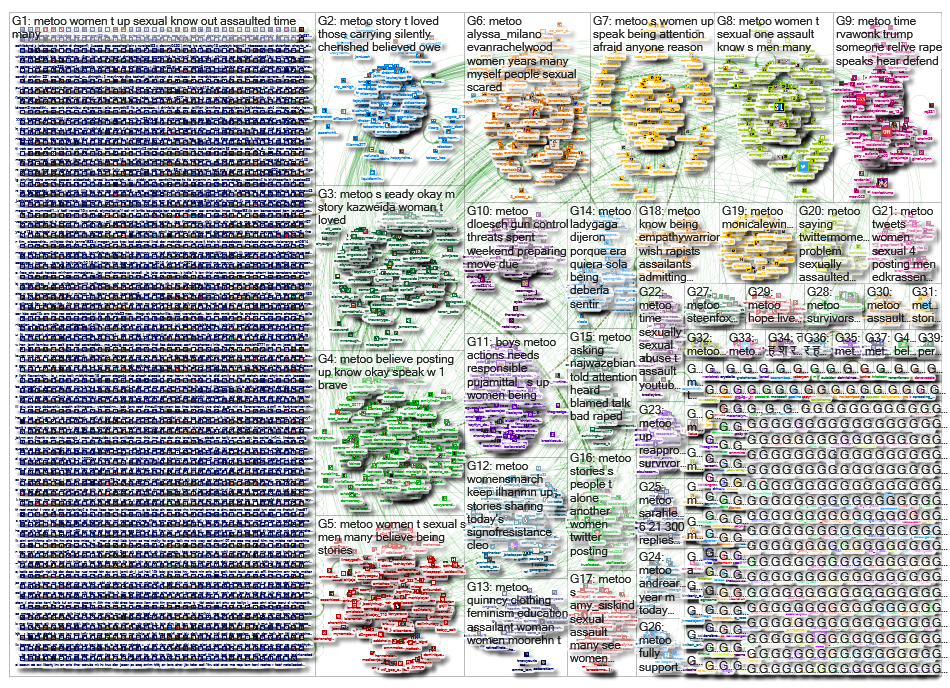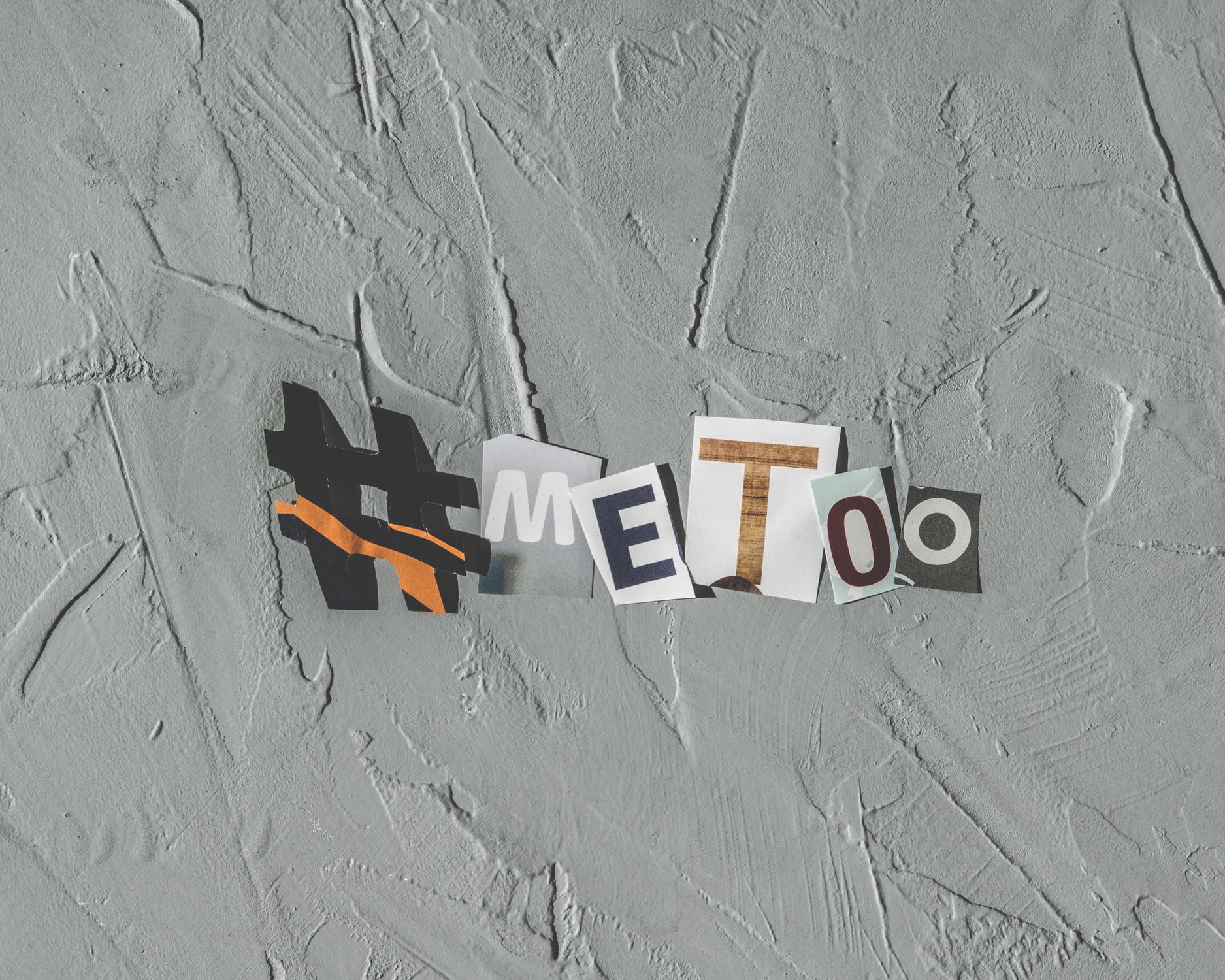By Kristin Schlotterbeck After reading through the Pew Research Center’s mapping of Twitter topic networks, I was curious to compare a few other network maps and was shocked at what I found.
NodeXL, the same mapping application used by the Pew Research Center, maintains an ongoing open-source graph gallery, filled with maps of all sorts of data sets users have explored and uploaded.
I decided to search for a network map of the #MeToo movement, which was the largest hashtag trend that came to mind. The hashtag, which EzyInsights named “The Viral Event of 2017,” was originally envisioned by Tarana Burke in 2006, but amplified via a retweet by Alyssa Milano on October 15, 2017. The tweet was in response to ongoing discussions about the sex crimes committed by Harvey Weinstein after an article appeared in the New York Times detailing his ongoing campaign to silence the women he victimized.
Based on the nature of how the movement trended, I anticipated the network map would look like a Broadcast Network–with Alyssa Milano in the center of a node with maybe a few smaller connected clusters.
Instead, I was surprised to find this map from October 15, 2017:

[The interactive version is interesting, if you can wait for it to load, and can forgive the glitches.]
G1, the largest group, shows many isolated participants using #MeToo, making the map more akin to a Brand Cluster, than a Broadcast Network. This is pretty impressive, given the data set is pulled from the same day as the tweet by Milano. The number of people sharing their experiences and using the hashtag became so large almost immediately that connections between participants became less likely.
This seems to explain at least partially some of the power behind this movement–propelled forward by the strength of so many individual participants, the movement went on to condemn Larry Nassar, Matt Lauer, Al Franken, Louis C.K., and a number of other high profile celebrities.
It also explains why the #MeToo movement has sustained and continues to impact our culture and social norms in a way many other broadcast stories may not have through the power of the collective experience.




This is fascinating, Kristin! It makes me think of the six degrees of separation where we’re all just six connections away from each other. However, with social media, we’re far more connected than we think. According to a study Facebook released in 2016, social media lessens those six degrees of separation to three and a half. This, I think is really is paramount in this graphs, mapping out the use of hashtags. I really like how you pointed out that these are more akin to a Brand Cluster. It makes me wonder that if in our own social circles, are we all Brand Clusters with our only three and a half degrees of separation. It also makes me wonder what the next big hashtag movement will be in the years to come. Personally, I hope the #MeToo movement keeps its momentum on social sites and in our daily lives!
Kristin – Wow, I’ve never seen a social movement map drawn out like this before. What a unique way to observe how a social trend / movement / hashtag moves around the digital universe. Like Tess, there first thing I thought of was the six degrees of separation – but now with social media these connections can be amplified incredibly quickly. So many people were contributing to the #MeToo movement so quickly that it was unclear how exactly it was spreading. It’s fascinating to see this visually! Thanks for sharing!
Wow, Kristin! This hashtag map is incredible! I agree with Hana, this is a very unique way to observe a hashtag moving around the digital universe. It’s interesting that the #MeToo hastag moved around the digital world that quickly in a day. Is this map only showing the #MeToo hastag on Twitter? I’d be interested to see a map that analyzed the hastag use on different apps including Instagram and Facebook.
First, this is so cool.
Second, I am curious to see what other social movement’s maps are going to look like. It would be interesting to identify differences and found out how, when and where the whole movement gain the biggest momentum. This would be a very interesting case study topic.
Kristin: This is why Twitter and our social networks are such powerful tools in the digital age. In this vein, it’s particularly interesting to view this in the context of political polarization and the types of topics shared in clusters. I found an MIT article to effectively illustrate how political polarization manifests itself in Twitter activity and why these divides, or gaps, are so hard to bridge. MIT categorized this by country – from the U.S. and Russia to Turkey and Iran – and shed light on a divided press. Really interesting, and I highly recommend a quick view.
https://www.technologyreview.com/s/611807/this-is-what-filter-bubbles-actually-look-like/
Thanks for sharing this, it’s fascinating to see the network map of a hashtag gone recently viral. Honestly it gives me hope about social media seeing how the #metoo movement led to a revolution in openness around sexual harassment and assault. I also think it’s interesting to see that there were clearly multiple influencers catching fire at the beginning, it wasn’t just Alyssa Milano who made this happen. And then as you say “the hashtag became so large almost immediately that connections between participants became less likely.” This reorients my view of the #metoo movement. Was it dependent on a famous person spreading it? Or could it have caught fire without celebrity?
Super cool – thanks for sharing, Kristin! Per usual, just when I start getting all down about social media, I am reminded of the many powerful ways social media can be a powerful and positive tool. Unfortunately, I missed the class where network maps were discussed so this is still relatively new to me, but there are clearly plenty of resources to review network maps or create our own.
I just skimmed an article today on the topic of “brand communities” and how they’re on the rise while the impact of influencers is dropping. This #metoo map is a clear illustration of that. (If I can find the article, I’ll try to post it!)